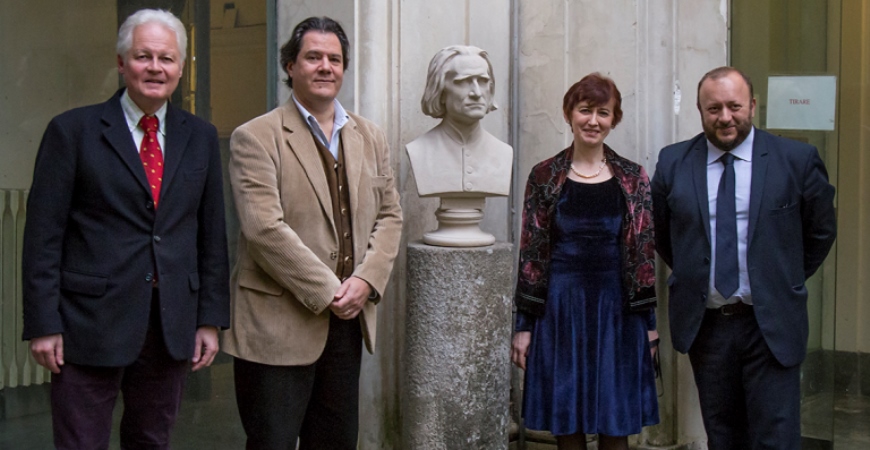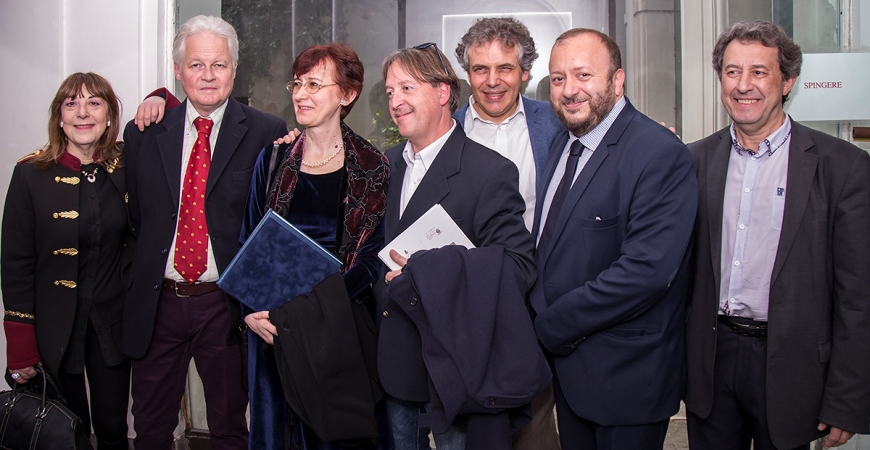Liszt Ferenc Memorial Museum and the Liszt Academy Foundation donate statue to the Accademia di Santa Cecilia in Rome
On 4 April, the director of the Liszt Ferenc Memorial Museum and Research Centre, Dr Zsuzsanna Domokos presented the Conservatorio di Santa Cecilia and the Accademia di Santa Cecilia with the bust of Ferenc Liszt.
The presence of Liszt was a decisive factor in Rome’s music life in the 19th century: it was in the spring of 1839 that the composer had visited the Eternal City for the first time, and being a prominent pianist, he was elected an honorary member of the Accademia di Santa Cecilia. After settling in Rome for good in October, 1861, then as an active member of the Accademia, he greatly contributed to the evolving concert life of the city. With the help of his most important student, the pianist Giovanni Sgambati and of another friend, the violinist Ettore Pinelli, soon joined by many other instrumentalists, Liszt enhanced the establishment of the first public music institution, the Liceo Musicale di Santa Cecilia - predecessor of today’s Conservatorio di Santa Cecilia - as part of the Accademia di Santa Cecilia. The Dante Hall, which was to become one of the most significant concert venues in Rome from the 1970s, was – thanks also to Sgambati - inaugurated on 26 February, 1866 with the premiere of Liszt’s Dante Symphony. This was the first time that Sgambati had been acting as a conductor, yet he was highly successful in his new role. Later, Liszt also supported Sgambati’s composing career, as is evidenced by a number of music scores kept in the music library in Budapest. As the advisor of the Accademia di Santa Cecilia, Liszt attended several general assembly meetings, and with his advice, he contributed to the larger-scale music events organised by the Accademia. His cantata, Cantantibus organis for the feast of Saint Cecilia was performed first at the inauguration of a Palestrina monument in Rome in 1880. He composed many of his later works in Rome and Tivoli and also the majority of his masterpiece, the oratorio Christus.

From left to right: musical advisor of the Collegium Hungaricum in Rome, musicologist, János Herczog, the director of the Conservatorio di Santa Cecilia Roberto Giuliani, the director of the Liszt Ferenc Memorial Museum and Research Centre, Zsuzsanna Domokos and the director of the Collegium Hungaricum in Rome, Dr István Puskás
The living tradition of the Cappella Sistina, which was also the determining factor of the interpretation and renaissance of Palestrina’s music - had a life-long impact on Liszt, the composer. Liszt’s reform ideas in church music was also highly affected by the Italian initiatives known to him by his personal network of friends. The unique spell of the city charmed him from the very first moment. In 1863, he penned the following lines: „I would say that in I support the method that has been in constant use in Rome regarding Christian monuments. Were not the magnificent columns of the church Santa Maria degli Angeli taken from Diocletian’s Baths, and the bronzes of the Pantheon melted to create Saint Peter’s altar baldachin? One cannot come to the end of the list of similar transformations at every step one takes and is astonished by the harmony of the divine plan between that which once was, now is and will be. I am particularly attached to Rome, where I am hoping to come to eternal rest, so I repeat with Saint Bernard: ’Ibi aër purior, coelum apertius, familiaror Deus!”

From left to right: musicologist and member of the Conservatorio di Santa Cecilia Campa, musical advisor of the Collegium Hungaricum in Rome, music historian, János Herczog, the director of the Liszt Ferenc Memorial Museum and Research Centre, Zsuzsanna Domokos, the clarinettist and organiser of the Franz Liszt Festival in Albano, Maurizio d'Alessandro, the pianist Gregorio Nardi, the director of the Collegium Hungaricum in Rome, Dr István Puskás, and the Head of the Keyboard and Harp Department of the Liszt Ferenc Academy of Music, Kálmán Dráfi
The bust by Caspar Clemens von Zumbusch was made in 1867 - during Liszt’s Roman years - while he was on a visit in Munich. This statue was highly popular already in Liszt’s life, and several institutions would order a copy. Even Liszt was very fond of the work and had copies prepared to give them away as private gifts. A photograph of the bust has been found in the Sgambati-heritage accompanied with a Bible passage in Liszt’s penmanship. There is another copy in Liszt’s home in Budapest – now the the Liszt Ferenc Memorial Museum and Research Centre operating within the framework of the Liszt Ferenc Academy. Gyula Fekete, the Vice President of International and Scientific Affairs must be thanked for initiating and organising the donation of this new copy made by Balázs Szemerey. Moreover, gratitude is due to the Board of the Liszt Academy Foundation for financially supporting the creation of the work. The statue could not have been handed over without the keen help of the management of the Collegium Hungaricum in Rome, but the openness and ready acceptance of the bust on the part of the Accademia and Conservatorio di Santa Cecilia were also essential prerequisites. The inauguration ceremony was linked to the piano masterclass given by the department head, Kálmán Dráfi in the Conservatorio di Santa Cecilia the previous week.


